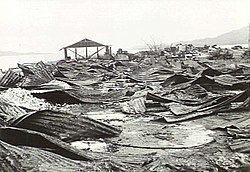
The Territory of Papua comprised the southeastern quarter of the island of New Guinea from 1883 to 1975. In 1883, the Government of Queensland annexed this territory for the British Empire. The United Kingdom Government refused to ratify the annexation but in 1884 a protectorate was proclaimed over the territory, then called "British New Guinea". There is a certain ambiguity about the exact date on which the entire territory was annexed by the British. The Papua Act 1905 recites that this happened "on or about" 4 September 1888. On 18 March 1902, the Territory was placed under the authority of the Commonwealth of Australia. Resolutions of acceptance were passed by the Commonwealth Parliament, which accepted the territory under the name of Papua.

Milne Bay is a province of Papua New Guinea. Its capital is Alotau. The province covers 14,345 km² of land and 252,990 km² of sea, within the province there are more than 600 islands, about 160 of which are inhabited. The province has about 276,000 inhabitants, speaking about 48 languages, most of which belong to the Eastern Malayo-Polynesian branch of the Austronesian language family. Economically the province is dependent upon tourism, oil palm, and gold mining on Misima Island; in addition to these larger industries there are many small-scale village projects in cocoa and copra cultivation. The World War II Battle of Milne Bay took place in the province.

Alotau is the capital of Milne Bay Province, in the south-east of Papua New Guinea. It is located on the northern shore of Milne Bay. The town is located within Alotau Urban LLG.

Sorong is the largest city and the capital of the Indonesian province of Southwest Papua. The city is located on the western tip of the island of New Guinea with its only land borders being with Sorong Regency. It is the gateway to Indonesia's Raja Ampat Islands, species rich coral reef islands in an area considered the heart of the world's coral reef biodiversity. It also is the logistics hub for Indonesia's thriving eastern oil and gas frontier. Sorong has experienced exponential growth since 2010, and further growth is anticipated as Sorong becomes linked by road to other frontier towns in Papua's Bird's Head Peninsula. The city had a population of 190,625 at the 2010 Census and 284,410 at the 2020 Census; the official estimate was 295,809. In mid 2022, 47.34% of the city population were Protestant, 44.82% were Muslim, and 7.55% Catholic, with minorities of Buddhists and Hindus. The city is served by Domine Eduard Osok Airport.

This page is a list of districts of Papua New Guinea.

The Jomard Islands are an uninhabited island group in the Coral Sea, belonging to Papua New Guinea, It lies to the east of Montemont Islands in the Louisiade Archipelago.
Gonubalabala Island (on maps as Gona Bara Bara) is an island on the southern side of East Channel, Milne Bay Province, Papua New Guinea. It is located South east of Logea Island. It is a home island of the Mailulu clan.
Logea Island is a large island separating West Channel, East Channel and China Strait, just south of Milne Bay, in Milne Bay Province, Papua New Guinea.
Kwato Island an island in China Strait, Milne Bay Province, Papua New Guinea.
Saliba Island is a large island in Milne Bay Province, Papua New Guinea.
Kitai Katu Island is an island in the Louisiade Archipelago, off the east coast of Basilaki Island, Milne Bay Province, Papua New Guinea.
Dobu Rural LLG is a local-level government (LLG) administering Dobu Island in Milne Bay Province, Papua New Guinea.
Alotau Rural LLG is a local-level government (LLG) of Milne Bay Province, Papua New Guinea.
Daga Rural LLG is a local-level government (LLG) of Milne Bay Province, Papua New Guinea.
Maramatana Rural LLG is a local-level government (LLG) of Milne Bay Province, Papua New Guinea.
Suau Rural LLG is a local-level government (LLG) of Milne Bay Province, Papua New Guinea. The Suau language is spoken in the LLG.
Bwanabwana Rural LLG is a local-level government (LLG) of Milne Bay Province, Papua New Guinea. The Bwanabwana language is spoken in the LLG.
Murua Rural LLG is a local-level government (LLG) of Milne Bay Province, Papua New Guinea.
Yaleyamba Rural LLG is a local-level government (LLG) of Milne Bay Province, Papua New Guinea.
West Ferguson Rural LLG is a local-level government (LLG) of Milne Bay Province, Papua New Guinea.








